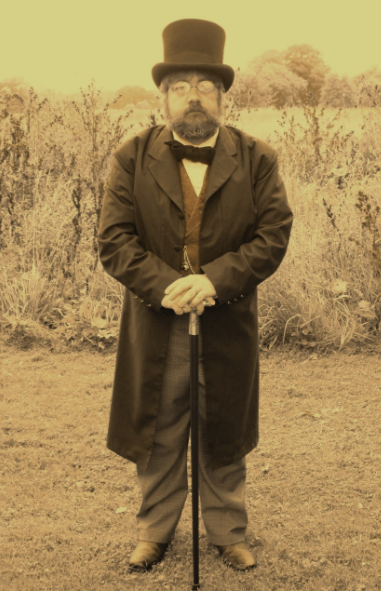Egremont Russet - a biography
Egremont was born in 1835, the only child of William Russet, the vicar of Allerton Mauleverer, Yorkshire, and his wife Rosemary. A bright child, he was awarded a scholarship to Ripon Grammar School, where he thrived in his academic studies, and went on to read Anglo-Saxon, Norse and Celtic at King’s College, Cambridge. He spent most of his adult life in West Africa as a Methodist missionary but having grown up in and around Allerton Castle it perhaps isn’t surprising that he was somewhat eccentric, this manifesting itself in his establishing the School of Norse Mythology in Oshogbo, in present-day Nigeria. Popular, hardworking and ascetic, he was successful in his missionary work and despite all odds his School flourished. In seeking to expand the popularity of Norse mythology in West Africa, Egremont sought to establish a new school in Timbuktu but was last seen near Mopti in July 1874, heading in a northerly direction without a solar topi on his head. It was feared he succumbed to the disorienting affects of heatstroke and the harsh conditions of the Sahel but new information has recently come to light that suggests Egremont was more resourceful and resilient than originally thought. It now appears he may have reached Gao, a walk of over 800 kilometres from Mopti (assuming he followed the course of the Niger River, the direct route being somewhat shorter but almost entirely without any source of water).
For reasons known only to herself, a jobbing humanitarian aid worker undertook a cycling holiday through the Sahel in the early 1990s, a time when that region was perhaps better known for its somnolence than the unfortunate and violent insurgencies that make such a journey impossible today. On reaching Gao, our holidaying humanitarian received a letter, poste restante, requesting her urgent presence in Mogadishu, where a humanitarian catastrophe was unfolding as a result of the civil war there and the world's hapless response to it.
By virtue of various Telex massages transmitted to and from the Médecins sans Frontières regional headquarters in Abidjan, sent via their sub-offices in Ougadougou and with the help of the friendly head librarian of Gao's newly built municipal library (a gift from the Swedish Development Agency, who had provided funds for the building, on the understanding that the Danish Development Agency would provide money for books but whose funding had yet to materialise, resulting in a fine library building with no books and a head librarian with time on her hands) she was informed that an aeroplane would be sent to collect her and requesting she wait at Gao airstrip (it would be misleading to call the relatively flat and relatively smooth patch of gravel, sand and grass an airfield, let alone an airport, given that its purpose was to be a thoroughfare for vehicles, bicycles and pedestrians on their way to or from the centre of Gao from all points south of the town, as well as provide grazing for all the goats of the locality).
Being an experienced traveller she set up camp under the shadiest acacia tree she could find, knowing it might be several days before a single-engine Cessna would arrive to pick her up. As she waited, her back resting against the trunk, she read her battered copy of James Joyce's Dubliners and as she did so she slowly revolved around the tree, trying to stay in the shade, keeping the trunk between her and the burning sun as it moved across the sky. As she shuffled around the tree, she gradually hollowed out a shallow trench in the sand and gravel around the tree and on the third morning she felt the heel of her boot strike something hard. Having gained a degree in Archaeology from a respectable European university her interest was piqued, so she set about a careful excavation and before long she had in her hands a pair of early Victorian spectacles, intact but with badly scratched lenses, contained within a metal case on which the initials E R were still just visible. The metal case was completely filled with sand and clearly had not been disturbed for a long time. We cannot be certain, of course, that the spectacles belonged to Egremont Russet himself but their antiquity and the condition in which they were found suggests it is a distinct possibility, in which case it may be that he did reach Timbuktu after all and was, perhaps, on his way back to Oshogbo when he, too, rested awhile under the shadiest acacia tree in Gao.
And what of the spectacles now? When the Cessna eventually arrived, piloted by a young Canadian who appeared to wear Ray-Ban Wayfarer sunglasses no matter the weather or the time of day or night, our jobbing humanitarian quickly re-buried the spectacles where she had found them, hoping it would encourage her to return to Gao, so she could resume and complete her cycle tour of the Sahel. Events and her career, however, took her elsewhere, so it's very likely they are still there, buried beneath the shadiest acacia tree in Gao.
Fortunately, for those who are interested in the life and times of Egremont Russet, the archaeological method she had learned at the respectable university led her to record meticulously the findings of her excavation in her diary - it’s fascinating stuff - and to take several photographs of the spectacles, one of which is shown below.
Thanks for reading these idle meanderings; you should have better things to do.




